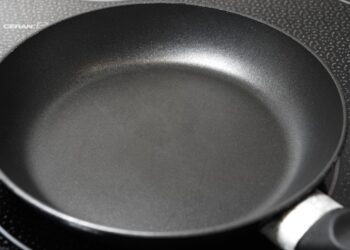Teflon is a word you’ve probably heard, especially if you’re a cooking enthusiast. Teflon is a material that has non-stick and heat-resistant properties, used in making frying pans. Not just in frying pans, you can find teflon in clothes and even industrial machines. Despite its benefits, teflon can cause some health issues if it isn’t used properly.
While cooking in a teflon cookware, it is possible for it to overheat in the course of cooking. When this happens, fumes are released which causes teflon flu or polymer fume fever when inhaled. In this article, we’re going to look at the symptoms, causes and treatment of teflon flu.

What is Teflon?
Teflon is made from a material called polytetrafluoroethylene (PTFE), which is normally safe to use. But if you heat it too much, it breaks down and releases harmful fumes into the air.
How this happens is when the cooking temperature is high above 260° C (500°F), the PTFE starts to break down. If it gets to around 350°C (662°F) or higher, it releases toxic gasses like perfluoroisobutene (PFIB) and carbonyl fluoride.
When you breathe in these fumes, they can irritate your lungs and cause an inflammatory response in your body, leading to teflon flu.
Symptoms of Teflon Flu
- Fever
- Chills
- Fatigue
- Muscle aches
- Headache
- Dry cough
Note: These symptoms can get worse depending on how long you’ve been exposed to the fumes. Most of the time, these symptoms are mild and can show up a few hours after exposure, lasting from 12 to 48 hours.
Causes of Teflon Flu
One major cause of teflon flu is overheating your teflon cookware, as mentioned earlier. Another thing to watch out for is using damaged or scratched teflon cookware. If the non-stick coating is scratched or damaged, it can release particles into the air more easily, especially when heated which eventually causes teflon flu.
Furthermore, cooking in a kitchen with poor ventilation can also increase your chances of getting teflon flu, if you cook with teflon cookware. Without proper airflow, any fumes from overheating teflon can build up in the air. This makes it more likely for you to breathe in those fumes and end up with the symptoms of teflon flu.
How Do You Prevent Teflon Flu?
Teflon flu becomes so easy to get if the teflon cookware is scratched. So you have to use cooking utensils that won’t scratch the non-stick surface of the teflon cookware, like a wooden or silicone utensil. Sometimes, stacking pots and pans on top of each other can cause scratches, so you best avoid doing so.
Furthermore, we’ve stressed on the effect of overheating teflon cookware, so keep that in mind as well. Lastly, you can decide to go for alternative cookware made from stainless steel, ceramics, or cast iron. These types of cookware can handle overheating and don’t produce fumes like teflon cookware.
Bottom Line
Teflon cookware is a great cookware option because of their non-stick properties. However, when this cookware is overheated or scratched, it produces fumes which cause people to have teflon flu symptoms when they inhale it.
The good thing is that you can prevent these things from happening if you don’t use utensils that scratch the teflon cookware, reduce the heat on the stove or use stainless steel or ceramic cookware. Share this info with your friends and family to keep everyone safe while cooking.

















